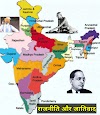How Reverse Thrust Helps Aircraft Slow Down and the Different Types Explained
Aircraft Thrust Reversers:
When you watch an aircraft touch down on the runway, you might notice a distinctive roar as it lands. Ever wondered why the engine noise gets louder during this crucial moment? That's the sound of thrust reversers at work, playing a crucial role in slowing down the aircraft on the ground.
What is Reverse Thrust?
Aircraft thrust reversers are systems designed to redirect the exhaust airflow of gas turbine engines forward upon landing to slow the aircraft speed. They essentially rotate the direction of the engine thrust without having to rotate the entire engine. This redirection of exhaust helps in providing additional deceleration during the landing rollout.
Why Reverse Thrust?
Thrust reversers enhance an aircraft’s braking efficiency, especially on shorter runways or in adverse weather conditions. By deploying reversers on touchdown, the aircraft can reduce reliance on wheel brakes at higher speeds. Ground spoilers, which dump lift, also contribute to securing the aircraft on the runway.
Types of Aircraft Reverser Systems:
Aircraft employ various thrust reverser systems to enhance braking efficiency during landing. Here's a brief look at four distinctive types:
1. Clamshell Reversers (Target-Type Reversers):
- Description: Simple, hinged doors resembling clamshells cover the rear section of the engine exhaust nozzle.
- Operation: When deployed, these doors redirect exhaust gases forward, generating reverse thrust.
- Common Usage: Found on early large passenger jets and business aircraft.
2. Cascade Thrust Reversers (Bucket Reversers):
- Description: Utilizes a series of blocker doors that extend into the exhaust stream.
- Operation: Blocker doors divert airflow forward, contributing to reverse thrust.
- Common Usage: Frequently seen on newer generation widebody and narrowbody passenger jets.
3. Pivot Door Thrust Reversers:
- Description: In the Pivot Door Thrust Reverser system the entire engine or nacelle assembly pivots to direct the exhaust forward.
- Operation: Unlike other designs, this system relies on a pivoting motion for reverse thrust.
- Common Usage: Seen on older Airbus aircraft, including the A330ceo and certain A320 models.
4. Cold Stream Thrust Reversers:
- Description: Redirects only the cold stream of air bypassed in modern turbofan engines.
- Operation: Focused on manipulating the bypassed cold airflow for braking purposes.
- Common Usage: Present in modern passenger aircraft like the Airbus A350 and Boeing 787.
Each type showcases unique engineering solutions, adapting to the specific needs and designs of different aircraft models. Together, they play a crucial role in ensuring safe and efficient landings across the aviation landscape..
Do All Engines Need Reversers?
Not necessarily. The Airbus A380, for example, only features cascade-type reversers on its inboard engines, as two reversers provide sufficient thrust.
Turboprop Aircraft and Reverse Thrust
Turboprop aircraft do not have traditional thrust reversers but use the 'beta range' or 'beta mode,' changing the angle of propeller blades to create reverse thrust on the ground.
Can Reversers Be Used in the Air?
In general, no. Commercial aircraft are designed to prevent thrust reversers from deploying in flight due to safety concerns. The Boeing C-17 Globemaster is an exception, using all four reversers to increase its rate of descent during tactical maneuvers.
Why Can't Jets Use Reverse Thrust to Reverse on the Ground?
Using thrust reversers for ground movement has fallen out of favor due to safety regulations at airports. Reversers generate powerful forces that can lead to uncontrolled movements, potential collisions, and pose risks to ground crew and equipment.
In conclusion, thrust reversers are vital tools contributing to a safe and swift landing. The next time you witness an aircraft landing, listen for the roar and know that it's the sound of these ingenious systems at work.
Also Read
Full Authority Digital Engine Control (FADEC) System Description & Operation














0 Comments